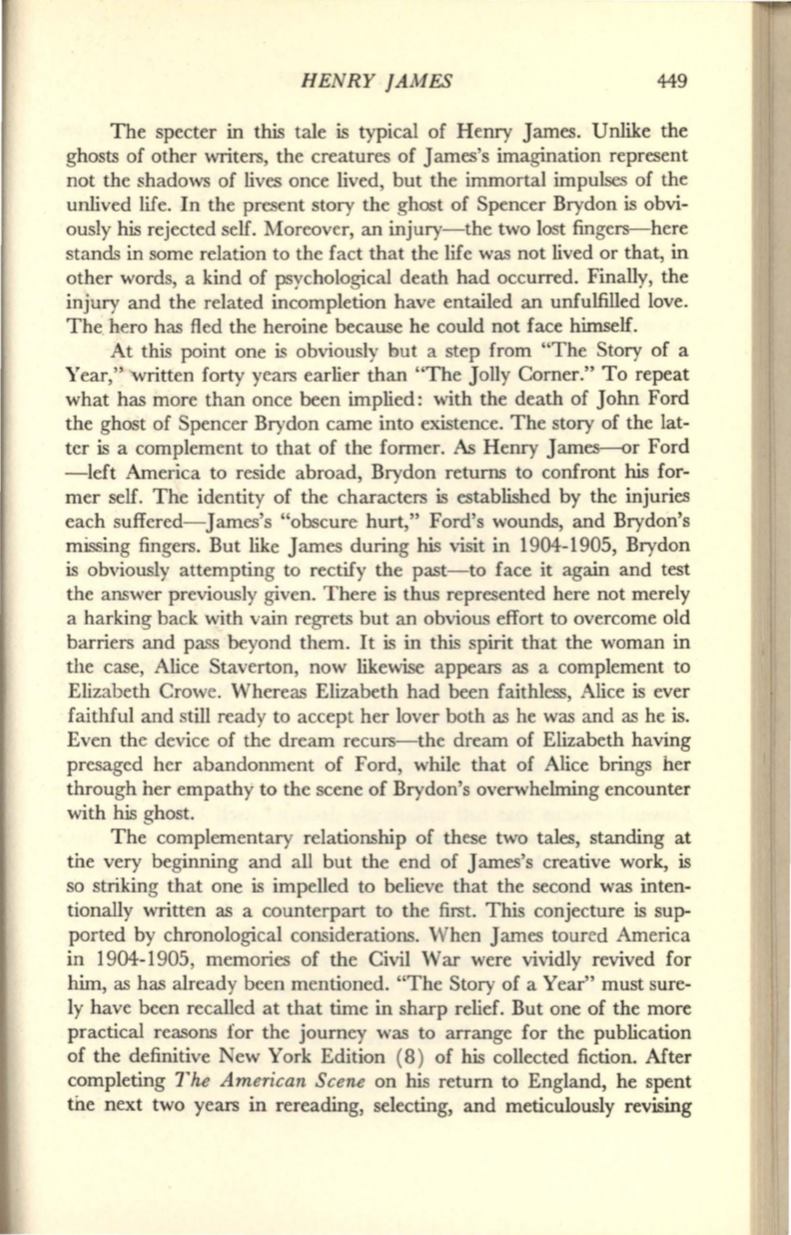
HENRY JAMES
449
The specter in this tale is typical of Henry James. Unlike the
ghosts of other writers, the creatures of James's imagination represent
not the shadows of lives once lived, but the immortal impulses of the
unlived life. In the present story the ghost of Spencer Brydon is obvi–
ously his rejected self. Moreover, an injury- the two lost fingers-here
stands in some relation to the fact that the life was not lived or that, in
other words, a kind of psychological death had occurred. Finally, the
injury and the related incompletion have entailed an unfulfilled love.
The. hero has fled the heroine because he could not face himself.
At this point one is obviously but a step from "The Story of a
Year," written forty years earlier than "The Jolly Corner." To repeat
what has more than once been implied: with the death of John Ford
the ghost of Spencer Brydon came into existence. The story of the lat–
ter is a complement to that of the former.
As
Henry James--or Ford
-left America to reside abroad, Brydon returns to confront
his
for–
mer self. The identity of the characters is established by the injuries
each suffered-James's "obscure hurt," Ford's wounds, and Brydon's
missing fingers. But like James during
his
visit in 1904-1905, Brydon
is obviously attempting to rectify the past-to face it again and test
the answer previously given. There is thus represented here not merely
a harking back with vain regrets but an obvious effort to overcome old
barriers and pass beyond them. It is in this spirit that the woman in
the case, Alice Staverton, now likewise appears as a complement to
Elizabeth Crowe. Whereas Elizabeth had been faithless, Alice is ever
faithful and still ready to accept her lover both as he was and as he is.
Even the device of the dream recurs- the dream of Elizabeth having
presaged her abandonment of Ford, while that of Alice brings her
through her empathy to the scene of Brydon's overwhelming encounter
with his ghost.
The complementary relationship of these two tales, standing at
the very beginning and all but the end of James's creative work, is
so striking that one is impelled to believe that the second was inten–
tionally written as a counterpart to the first. This conjecture is sup–
ported by chronological considerations. When James toured America
in 1904-1905, memories of the Civil War were vividly revived for
him, as has already been mentioned. "The Story of a Year" must sure–
ly have been recalled at that time in sharp relief. But one of the more
practical reasons for the journey was to arrange for the publication
of the definitive New York Edition (8) of his collected fiction. Mter
completing
The American Scene
on his return to England, he spent
the next two years in rereading, selecting, and meticulously revising


